Invisalign vs. Traditional Braces: Which Choice Is Right for You?
When considering orthodontic treatment, the option in between Invisalign and standard braces provides several vital aspects that warrant mindful assessment. Invisalign uses a discreet alternative with removable aligners, while traditional dental braces supply a much more visible yet efficient remedy for serious misalignment. Each choice encompasses distinct advantages and drawbacks related to appearances, comfort, treatment duration, and cost. Comprehending these nuances is critical for making an informed decision that lines up with your personal choices and way of living. The inquiry continues to be: which option will best meet your orthodontic demands and assumptions?
Introduction of Treatment Options

In contrast, conventional braces consist of steel brackets and cords that are bound to the teeth. This method uses continuous stress in time to achieve positioning. While effective for intricate orthodontic problems, standard braces require routine check outs for adjustments and can posture difficulties in maintaining dental hygiene as a result of the trouble of cleaning up about brackets and cables.
Both alternatives have their qualities, and the selection typically rests on particular oral conditions, lifestyle preferences, and individual conformity. Inevitably, speaking with an orthodontic specialist is crucial for establishing the most appropriate therapy plan customized to individual requirements. Comprehending the subtleties of each choice can considerably affect the total success of orthodontic therapy.
Visual Considerations
A significant element affecting the option in between Invisalign and conventional dental braces is the visual appeal each therapy supplies. Invisalign aligners are crafted from clear plastic, making them basically unseen when put on.
On the other hand, standard dental braces are composed of steel braces and cables, which can be much more noticeable. While advancements in orthodontic modern technology have resulted in the development of smaller sized braces and tinted elastics, typical dental braces still keep an even more conspicuous profile. For some individuals, the exposure of braces might hinder them from looking for required treatment.
Inevitably, the option in between Invisalign and conventional dental braces might depend upon individual choices pertaining to visual appeals. People who focus on discernment commonly favor Invisalign, while those that are less worried about visibility may opt for traditional braces. Recognizing the aesthetic implications of each choice is important for making a notified decision that straightens with one's way of life and preferences.
Comfort and Convenience

In regards to convenience, Invisalign aligners read more are detachable, making it possible for clients to appreciate their preferred foods without constraint and preserve optimal oral health. Cleaning and flossing are simplified, as the aligners can be gotten during these regimens, whereas traditional braces call for careful steering around wires and braces.
In contrast, conventional braces necessitate regular adjustments, making them much less hassle-free for those with active timetables. On the whole, the comfort and comfort of Invisalign make it an attractive option for several individuals seeking orthodontic therapy.
Therapy Period and Performance
While both Invisalign and standard dental braces work in correcting dental imbalances, the period of treatment can vary significantly in between both alternatives. Typically, Invisalign treatment can take anywhere from 12 to 18 months, depending upon the intricacy of the instance. The clear aligners work internet by progressively shifting teeth right into their wanted positions, and routine follow-ups with an orthodontist help make sure development continues to be on course.
In contrast, typical braces frequently require a longer commitment, normally ranging from 18 months to 3 years. This is because of their fixed nature and the usage of braces and wires, which can be much more efficient for extreme misalignments and intricate instances (Invisalign). The therapy effectiveness of standard braces is well-documented, as they enable accurate changes and better control over tooth motion
Inevitably, the option between Invisalign and traditional dental braces may depend upon both the awaited treatment period and the certain dental concerns at hand. Consulting with an orthodontist is crucial, as they can provide customized referrals based upon individual demands, making sure the picked approach straightens with preferred results and timeframes.
Expense Comparison and Insurance Coverage Choices
Expense plays a significant role in the decision-making procedure for individuals thinking about orthodontic treatment, whether selecting Invisalign or traditional dental braces. Usually, the expense of Invisalign varieties from $3,000 to $8,000, while traditional braces generally cost between $2,000 and $6,000. Factors influencing these prices include the intricacy try this website of the instance, the period of therapy, and geographical area.
Insurance insurance coverage can dramatically impact out-of-pocket expenditures. Lots of oral insurance policy plans provide partial protection for orthodontic treatments, however the specifics can differ commonly. It is essential for people to evaluate their insurance plan to identify the level of coverage for either alternative. Normally, conventional dental braces may be more regularly covered by insurance coverage strategies contrasted to Invisalign, which some insurance companies categorize as a cosmetic treatment.
Additionally, numerous orthodontic methods provide adaptable layaway plan, making both treatment options much more accessible. Clients must inquire about prospective funding options and discount rates for ahead of time payments. Assessing the overall price, consisting of insurance advantages and layaway plan, is crucial for making an informed choice that lines up with both aesthetic choices and spending plan considerations.

Final Thought
In recap, the choice between Invisalign and standard dental braces rests on several factors, including visual preferences, convenience, treatment duration, and cost. Invisalign offers a discreet, detachable alternative that facilitates oral hygiene and dietary flexibility, while traditional braces may be better for complicated dental concerns and typically come with a reduced rate point. Inevitably, assessment with an orthodontist is necessary to analyze specific circumstances and figure out one of the most suitable treatment choice for achieving optimum oral positioning.
When considering orthodontic therapy, the option between Invisalign and traditional dental braces provides several essential elements that merit careful evaluation.Contrasting Invisalign and standard braces discloses unique therapy choices for orthodontic adjustment.While both Invisalign and traditional dental braces are effective in dealing with dental imbalances, the duration of therapy can differ substantially between the 2 options.Price plays a considerable duty in the decision-making process for people thinking about orthodontic therapy, whether choosing for Invisalign or traditional dental braces.In recap, the choice between Invisalign and typical dental braces hinges on several elements, including visual choices, convenience, treatment duration, and price.
Comments on “How Invisalign Functions: Your Overview to Clear Aligners and Their Effectiveness”